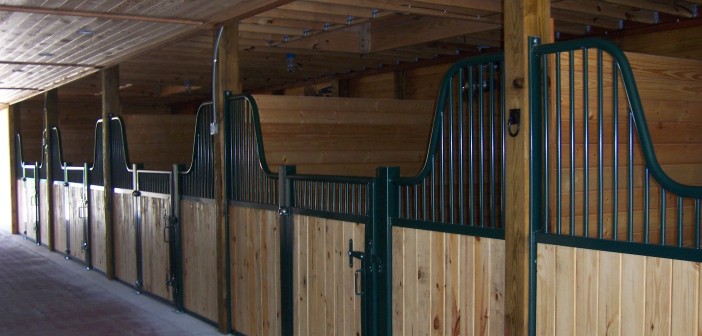Horse stalls are individual rooms in a stable that shelter horses from inclement weather and provide a convenient location at which horse owners can care for their animals. In the wild, horses would never live in stalls, and therefore there are a number of special considerations that must be taken into account if horses are to be stalled in a way that is conducive to their safety, comfort, and general well-being.
The stalls should be constructed out of sturdy materials such as wood or metal since they must be able to withstand the heaves and kicks of large, powerful animals. The length and width of the stall should be about 50% greater than the length of the horse since the animal must be able to lay down, arise, and turn around with ease. 12 feet x 12 feet for a 1,000 pound horse is average. Spirited horses will need more room to move than older or gentler beasts, and a mare and her foal are often best put together in a double-sized stall- that is, the divider is removed between two usual-sized stalls. The height of the stall should be about eight feet so the horse cannot kick over it.
The stall need not have a roof, but the roof of the stable should ideally be at least 10 feet up. Open space above the stall allows better air circulation and avoids letting the horse hit its head.
The doorway should be about four feet wide, either swinging open into the aisle (not into the stall) or sliding on a secure track so the bottom door area can take a good horse kick and not jump track. No more than three inches open space, if any space at all, should be under the door to keep the horse from catching his hoof there. According to the experts at HorseMatsCanada.com, you should “install the door latches out of reach of the horse- yes, they really can learn how to open them!” A high-up window with no glass and air vents along the top inside roof line of the stable make for good lighting and ventilation. As with people, without fresh air, breathing becomes difficult.
As to stall dividers, they are necessary to keep the horses from bothering each other, but it is good to leave some open panels on the upper half of the dividers so the horses can see one another. The dividers should be wide enough that they cannot get at each other, but being communal herd animals, they feel safer and will sleep more readily if they know that their comrades are their to “keep watch” while they take a nap. Horses only sleep three hours a day, but “rest” while standing frequently. Without any actual sleep for days on end, however, they will get fatigued and may even collapse and injure themselves.
The floor should have substratum layers of large gravel and then small gravel. The top layer can be a dirt-clay mix, rubber, cement, or wood. Rubber is great for easy maintenance, but is more expensive than dirt. A dirt floor needs to be re-clayed every few years. Cement and wood prevent pawing, but are harder on the horses hooves than dirt or rubber. Each flooring type has its advocates.
A water bucket should be attached at nose level to the stall wall and fresh, clean water should always be in it. Watch out for manure in the water bucket- obviously that water would need to be changed. Less obviously, you will want to keep the feed a good distance from the water so the horse won’t drop feed into his water and make it murky. The feed should be kept in an area that will not let it get too dirty, perhaps a concrete-covered corner. Bedding of straw or wood shavings will be needed so the horse can lie down without risking getting a lot of body sores and to soak up the urine. Less bedding is needed if one has a rubber floor. Remember that horses release pounds of feces and urine every day, and it will need to be cleaned out of the stall quickly to prevent odors and disease from accumulating. Finally, a metal ring to tie the horse to while working with him should also be fastened to the wall of the stall.
The above guidelines should be of help in keeping a horse that spends time in a stall happier and healthier than he would otherwise be. Horses need to be clean, well fed and watered, groomed, given adequate space, and allowed companionship of other horses, other animals, or of people.




